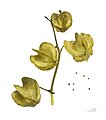
Datura is a genus of nine species of highly poisonous, vespertine-flowering plants belonging to the nightshade family (Solanaceae). They are commonly known as thornapples or jimsonweeds, but are also known as devil's trumpets. Other English common names include moonflower, devil's weed, and hell's bells. All species of Datura are extremely poisonous and potentially psychoactive, especially their seeds and flowers, which can cause respiratory depression, arrhythmias, fever, delirium, hallucinations, anticholinergic syndrome, psychosis, and even death if taken internally.
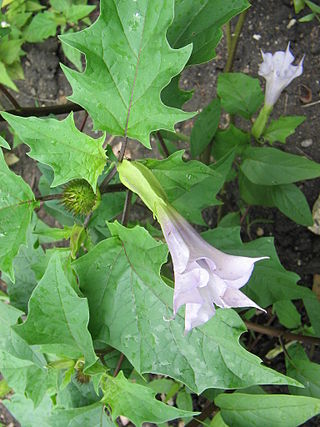
Datura stramonium, known by the common names thorn apple, jimsonweed, devil's snare, or devil's trumpet, is a poisonous flowering plant of the nightshade family Solanaceae. It is a species belonging to the Datura genus and Daturae tribe. Its likely origin was in Central America, and it has been introduced in many world regions. It is an aggressive invasive weed in temperate climates across the world. D. stramonium has frequently been employed in traditional medicine to treat a variety of ailments. It has also been used as a hallucinogen, taken entheogenically to cause intense, sacred or occult visions. It is unlikely ever to become a major drug of abuse owing to effects upon both mind and body frequently perceived as being highly unpleasant, giving rise to a state of profound and long-lasting disorientation or delirium with a potentially fatal outcome. It contains tropane alkaloids which are responsible for the psychoactive effects, and may be severely toxic.

Atropa is a genus of flowering plants in the nightshade family, Solanaceae: tall, calcicole, herbaceous perennials, bearing large leaves and glossy berries particularly dangerous to children, due to their combination of an attractive, cherry-like appearance with a high toxicity. Atropa species favour temperate climates and alkaline soils, often growing in light shade in woodland environments associated with limestone hills and mountains. Their seeds can remain viable in the soil for long periods, germinating when the soil of sites in which plants once grew is disturbed by human activity or by natural causes, e.g. the windthrow of trees. The best-known member of the genus Atropa is deadly nightshade - the poisonous plant par excellence in the minds of many. The pharmacologically active ingredients of Atropa species include atropine, scopolamine, and hyoscyamine, all tropane alkaloids having anticholinergic, deliriant, antispasmodic and mydriatic properties. The genus is named for Άτροπος (Atropos) - lit. 'she who may not be turned (aside)' - one of the Three Fates and cutter of the thread of life / bringer of death - in reference to the extreme toxicity of A.belladonna and its fellow species - of which three others are currently accepted.

Atropa belladonna, commonly known as belladonna or deadly nightshade, is a toxic perennial herbaceous plant in the nightshade family Solanaceae, which also includes tomatoes, potatoes, and eggplant (aubergine). It is native to Europe, North Africa, and Western Asia. Its distribution extends from Ireland in the west to western Ukraine and the Iranian province of Gilan in the east. It is also naturalised or introduced in some parts of Canada and the United States.

Flying ointment is a hallucinogenic ointment said to have been used by witches in the practice of European witchcraft from at least as far back as the Early Modern period, when detailed recipes for such preparations were first recorded and when their usage spread to colonial North America.

Hyoscyamus niger, commonly known as henbane, black henbane, or stinking nightshade, is a poisonous plant in the nightshade family Solanaceae. It is native to temperate Europe and Siberia, and naturalised in Great Britain and Ireland.
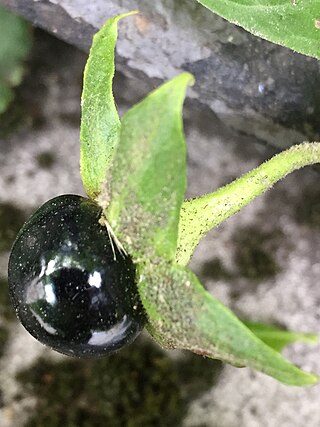
Deliriants are a subclass of hallucinogen. The term was coined in the early 1980s to distinguish these drugs from psychedelics and dissociatives such as LSD and ketamine, respectively, due to their primary effect of causing delirium, as opposed to the more lucid and less disturbed states produced by other types of hallucinogens. The term generally refers to anticholinergic drugs, which are substances that inhibit the function of the neurotransmitter acetylcholine. Common examples of deliriants include plants of the genera Datura and Brugmansia as well as higher than recommended dosages of diphenhydramine (Benadryl). A number of plant deliriants such as that of the Solanaceae family, particularly in the Americas have been used by some indigenous cultures to reach delirious and altered states for traditions or rituals, such as rites of passage, divination or communicating with the ancestors. Despite their long history of use, deliriants are the least-studied class of hallucinogens in terms of their behavioral and neurological effects.

Withania somnifera, known commonly as ashwagandha or winter cherry, is an evergreen shrub in the Solanaceae or nightshade family that grows in India, the Middle East, and parts of Africa. Several other species in the genus Withania are morphologically similar.

Anisodus tanguticus is a species of flowering plant belonging to tribe Hyoscyameae of subfamily Solanoideae of the nightshade family Solanaceae. It is thus closely related to Henbane and Deadly Nightshade. Solanaceae is a plant family which includes many important agricultural plants such as the potato and the tomato. It is mostly found growing in the Qinghai-Tibetan Plateau. A. tanguticus is collected and used mostly for its medicinal effects caused by the plant's biologically active nicotine and tropane alkaloids. It has a significant impact in China as one of the 50 fundamental herbs used in traditional Chinese medicine.

Tropane alkaloids are a class of bicyclic [3.2.1] alkaloids and secondary metabolites that contain a tropane ring in their chemical structure. Tropane alkaloids occur naturally in many members of the plant family Solanaceae. Certain tropane alkaloids such as cocaine and scopolamine are notorious for their psychoactive effects, related usage and cultural associations. Particular tropane alkaloids such as these have pharmacological properties and can act as anticholinergics or stimulants.

Iochroma arborescens is a species of flowering plant in the genus Iochroma, belonging to the nightshade family Solanaceae. Formerly it was considered the single species in the monotypic genus Acnistus. Common names include gallinero, mata-gallina, fruta-de-sabiá, hollowheart, wild tobacco, siyou, bastard sirio, galán arbóreo, tabaco de monte, nigüito, marieneira, güitite, and tabak djab.
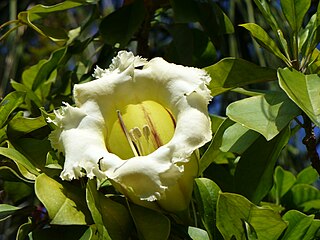
Solandra grandiflora, the showy chalicevine, or papaturra is a member of the nightshade genus Solandra and, like the other members of the genus, is a climbing plant with large, attractive, trumpet-shaped flowers. It is native to Central America and northern South America and is widely grown in the tropics as an ornamental. The green parts of the plant are highly toxic, due to tropane alkaloid content, and have caused deaths from anticholinergic poisoning, but the flesh of the ripe fruit is said to be edible. The fruits, which are globular and largely enclosed by the accrescent calyces, can reach a kilogram in weight and have a taste described as apple-like or melon-like.

Scopolia carniolica, the European scopolia or henbane bell, is a poisonous plant belonging to the family Solanaceae. It has dark violet flowers on long hanging stems. It grows to 60 centimetres (24 in) in height. Its toxicity derives from its high levels of tropane alkaloids, particularly atropine. The concentration of atropine is highest in the roots.
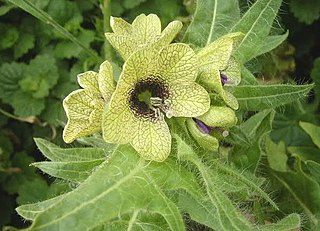
Hyoscyameae is an Old World tribe of the subfamily Solanoideae of the flowering plant family Solanaceae. It comprises eight genera: Anisodus, Archihyoscyamus, Atropa, Atropanthe, Hyoscyamus, Physochlaina, Przewalskia and Scopolia. The genera Archihyoscyamus, Atropanthe and Przewalskia are monotypic, the first being endemic to Turkey and Iran, the second to China and the third to Tibet.
Mandragora turcomanica, the Turkmenian mandrake, is a perennial herbaceous plant in the family Solanaceae, native to the Kopet Dag mountains in Turkmenistan and one location in neighbouring Iran. It differs from the mandrakes found around the Mediterranean chiefly by being larger.
Mandragora caulescens, the Himalayan mandrake, is a perennial herbaceous plant in the family Solanaceae, native to the Himalayas and mountainous regions of Myanmar and south-west China. One of the differences from the other species of Mandragora is that it has a stem, whereas they are stemless. Like all species of Mandragora, it contains tropane alkaloids, making it toxic. It is used in traditional Chinese medicine.

The Solanaceae, or nightshades, are a family of flowering plants that ranges from annual and perennial herbs to vines, lianas, epiphytes, shrubs, and trees, and includes a number of agricultural crops, medicinal plants, spices, weeds, and ornamentals. Many members of the family contain potent alkaloids, and some are highly toxic, but many—including tomatoes, potatoes, eggplant, bell and chili peppers—are used as food. The family belongs to the order Solanales, in the asterid group and class Magnoliopsida (dicotyledons). The Solanaceae consists of about 98 genera and some 2,700 species, with a great diversity of habitats, morphology and ecology.
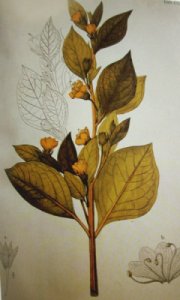
Atropa baetica is one of Europe's rarest wildflowers. A close relative of the infamous deadly nightshade its specific name derives from that of the Roman province of Hispania Baetica, while its common name refers to the Spanish region of Andalucía – both designating the area in the south of Spain where it is most frequently encountered. It is an attractive, perennial herbaceous plant bearing infundibuliform, yellow or greenish flowers and shiny, black berries. Like the other three species of Atropa, it is an extremely poisonous plant, containing a variety of tropane alkaloids with anticholinergic, deliriant, antispasmodic and mydriatic properties. Although most populations of the plant are to be found in Spain, it is not wholly confined to the Iberian Peninsula of Europe, occurring also in certain localities in Morocco and Algeria in the Atlas Mountains of North Africa. The Rif and the Baetic System, which face each other across the Alboran Sea, together constitute one of the finest of the Mediterranean biodiversity hotspots – rich in endemic species, of which Atropa baetica is a notable example..

Physochlaina is a small genus of herbaceous perennial flowering plants belonging to the nightshade family, Solanaceae, found principally in the north-western provinces of China although one species occurs in Western Asia, while another is found as far east as those regions of Siberia abutting the eastern borders of Mongolia and, furthermore, not only in Mongolia itself, but also in the Chinese autonomous region of Inner Mongolia. Some sources maintain that the widespread species P. physaloides is found also in Japan, but the species is not recorded as being native in one of the few English-language floras of the country. The genus is a valuable one, since its species are not only of considerable medicinal value, being rich in tropane alkaloids, but also of ornamental value, three species having been grown for the purpose, although hitherto infrequently outside botanical gardens. Furthermore, the genus contains a species formerly used as an entheogen in Siberia.

Alkekengi officinarum, the bladder cherry, Chinese lantern, Japanese-lantern, strawberry groundcherry, or winter cherry, is a species of flowering plant in the nightshade family Solanaceae. It is a close relative of the new world Calliphysalis carpenteri and a somewhat more distant relative to the members of the Physalis genus. This species is native to the regions covering Southern Europe to South Asia and Northeast Asia.













